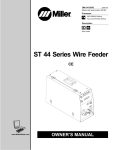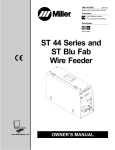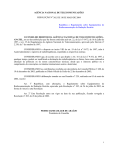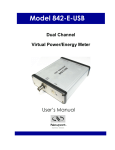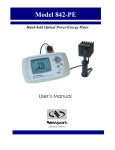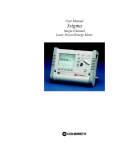Download CORRECT CRAFT G21 Operator`s manual
Transcript
PROSTAR P H O T O V O LTA I C S Y S T E M C O N T R O L L E R S OPERATOR’S MANUAL MODEL RATINGS PROSTAR-12 PROSTAR-20 PROSTAR-30 Rated PV current 12A 20A 30A Rated Load current 8A 16A 30A System voltage: 12 and 24 volts, auto selected ProStar models • Standard included in this • With LCD meter manual: CONTENTS 1.0 2.0 3.0 4.0 5.0 6.0 GENERAL INFORMATION.................................................... 2 QUICK START INSTRUCTIONS ............................................ 3 INDICATORS ...................................................................... 4 3.1 LED Indicators .................................................. 4 3.2 Digital Meter & Disconnect .............................. 5 INSTALLATION INSTRUCTIONS ............................................ 6 4.1 Polarity Protection ............................................ 6 4.2 Installation Procedure ...................................... 7 OPERATION........................................................................ 10 5.1 Controller Operation ........................................ 10 5.2 Controller Functions ........................................ 10 5.3 Inspection and Maintenance ............................ 11 5.4 Troubleshooting................................................ 12 SPECIFICATIONS ................................................................ 15 1.0 GENERAL INFORMATION Thank you for selecting the ProStar PV controller. The ProStar is a highly sophisticated controller using advanced technology and microprocessor control. The battery charging process has been optimized for longer battery life and improved system performance. Many functions of the ProStar are unique. Although the ProStar is very simple to use, please take the time to read this operator’s manual and become familiar with the controller. This will help you to make full use of the many advantages the ProStar can provide to your PV system. PRECAUTIONS “Always Put Safety First” • Always be very careful when working with batteries. Batteries can produce explosive hydrogen gas. A short-circuit can pull thousands of amps from the battery. 2 • Even though the system is only 12 or 24 volts, both the PV array and battery can contain lethal amounts of electrical power. • Do not splash water on the controller, do not allow water to enter the ventilation slots. • Do not touch the heatsink. Under certain operating conditions, the heatsink can become hot. • Always install the controller in a vertical position. Ensure adequate space for ventilation, and never block the ventilation slots. • Do not short-circuit the PV array while connected to the controller. This will damage the controller. • Do not exceed the current ratings of the controller. 2.0 QUICK START INSTRUCTIONS This section provides a brief overview of how to get started using the ProStar controller. However, please review the entire manual to ensure best performance and years of trouble-free service. 1. Mount the ProStar to a vertical surface. Allow space above and below the controller for air flow. The heatsink MUST be in a vertical (up & down) position. 2. Make sure the PV and load currents will not exceed the ratings of the ProStar model being installed. 3 3. Connect the BATTERY first. Observe that all LED’s flash in sequence one time. 4. Connect battery SENSE leads (if utilized). This is recommended if the controller is placed more than 2 to 3 meters from the battery. 5. Connect the PV (solar array). With sunlight, the green CHARGING LED will light in 2 minutes. 6. Connect the LOAD. If the LED indicators begin to flash, the load is shorted. Refer to the detailed installation instructions. 7. The BATTERY TYPE at start-up is sealed (LED on). If the PV system battery is a flooded type, use a piece of wire to touch the SELECT PIN to the battery minus terminal to change to flooded (LED goes off). This must be reset every time the battery is disconnected. 8. The ProStar will automatically select for a 12 or 24 volt system. If this is a 24 volt system, first check to confirm that the battery is above 17 volts, and boost-charge the battery if under 17 volts. 9. Observe the LED indicators. After a few minutes to clear delays and resets, the LED’s should operate per system conditions as described in the following chart (section 3.1). 10. For effective surge protection, it is recommended that the negative system conductor be properly grounded. 3.0 INDICATORS 3.1 LED INDICATORS The ProStar utilizes 5 LED (light emitting diode) indicators to provide controller and system status information. These are described in the following table. INDICATOR COLOR DESCRIPTION BATTERY TYPE Green ON: Sealed battery type OFF: Flooded battery type STATUS Green ON: PV array power available and charging battery OFF: PV array power is off 4 BATTERY CHARGE Green ON: Battery near full charge BATTERY CHARGE Yellow ON: Battery at middle capacity (about 35% to 80% SOC) NOTE: does not indicate a problem BATTERY CHARGE FLASH: Battery at low charge, warning ON: Load has been disconnected All LED’s Red SEQUENTIAL FLASH: Load is short-circuited High temperature shutdown High voltage disconnect Initial battery connection (startup) (flashes one cycle only) 3.2 DIGITAL METER & MANUAL DISCONNECT If your model is supplied with the LCD meter, the controller will include a precision 3-digit meter that displays battery voltage, PV array current and load current. The meter will automatically sequence between these 3 parameters. The 3 small green status LED’s will indicate which parameter is being displayed. The LCD meter will operate from -30°C to +85°C. The values displayed are accurate to within a few percent. However, please note that if the BATTERY SENSE is not connected, the voltage displayed will be reduced by the voltage drops in the battery wires. The red DISCONNECT button will provide an immediate disconnect of both the PV array and load when pushed (the button’s red LED turns on). To return the controller to normal operation, push the button a second time. Note that restarting the controller with the button will cause the controller to go through the start-up sequence with the normal delays and LED indications. 5 4.0 INSTALLATION INSTRUCTIONS 4.1 POLARITY PROTECTION (AND LED INDICATIONS) CAUTION: Although the ProStar is fully protected from reversed polarity, the system operator and other equipment may be at risk when polarities are reversed. Carefully check each connection and observe the LED’s to make sure polarity is correct. CONNECTION POLARITY RESULT AND LED INDICATION Battery Correct All 5 LED’s will sequence one time. BATTERY TYPE indicator will remain on (default is sealed). The green BATTERY CHARGE indicator will light within 15 seconds, and will then cycle to the correct state. Battery Reversed No LED’s will light. No damage will occur. Sense Correct No additional indications. Sense Reversed If the battery has been connected correctly, there will be sparking at the terminals. If the negative sense lead is connected first, no damage will occur (small possibility of damage if positive connected first). There will be no indications. PV Array Correct LED’s will light only if the battery has been connected. During daytime with battery present, the CHARGING indicator will light after a 2 minute delay. PV Array Reversed No damage will occur. The CHARGING indicator will not light after the 2 minute delay. Load N/A If a load short-circuit exists, load will instantly disconnect to protect the controller. LED’s will then sequence to indicate a short. 6 4.2 INSTALLATION PROCEDURE GENERAL INSTALLATION NOTES: • The ProStar prevents reverse current leakage at night, so a blocking diode is not required in the system. • The ProStar is designed to regulate ONLY PV power. Do NOT connect to any other type of power generator. • The ProStar automatically selects 12 or 24 volt setpoints at battery connection. Do not connect a battery larger than 24 vdc (12 cells) or the controller will be damaged. • The connector terminals will accept a maximum wire size of AWG #6 (solid/multistrand) or AWG #8 (fine strand) or a maximum wire diameter of 5.0 mm. Use a flathead insulated screwdriver (up to 5 mm). NOTE: Carefully observe the LED indications at each connection. Per the chart above, the LED’s will indicate proper polarity and a good connection. NOTE: Connections may be made in any order. However, the BATTERY must be connected first for the LED indicators to operate. The SENSE input will not power the LED’s. INSTALLATION STEPS: 1. Inspect the controller for shipping damage. Mount the ProStar to a vertical surface (4 stainless steel #8 self-tapping screws are included). Do not install directly over an easily combustible surface since the heatsink may get hot under certain operating conditions. NOTE: Heatsink must be in a vertical (up and down) position. Allow a minimum of 15 cm (6 inches) space above and below the controller for air flow. Install in an area protected from direct rain and extreme temperatures. If the controller is installed in an enclosure, some ventilation is recommended. If installed in a sealed enclosure, under extreme conditions the ProStar may, at times, reach 70ºC and disconnect the PV array briefly. 2. Confirm that the PV array and loads will not exceed the current ratings of the ProStar model being installed (see chart on front cover). 7 Multiple ProStar units can be paralleled at the system battery, but be careful that no PV sub-array exceeds a controller’s individual current rating. 3. BATTERY (+ and -) Before connecting the battery, check the open-circuit voltage of the system battery. It must be at least 8 volts for the controller to operate. If your PV system is 24 volts, the battery MUST be over 17 volts, or the controller will regulate at the 12 volt setpoints. Any battery starting at less than 11 (or 22) volts should be fully charged before connection to a PV system, or battery life will be significantly reduced. NOTE: The battery should be connected first. This will activate the controller self-protection features, and will power the LED’s to guide installation and start-up. Connect the battery and observe that all 5 LED’s flash in sequence one time. If the LED indicators do not sequence or the BATTERY TYPE LED does not light, check the battery polarity. The green, yellow or red BATTERY CHARGE LED will light depending on the battery charge state. 4. SENSE (+ and -) Battery sense leads are recommended if the controller is located more than 2 or 3 meters from the battery. This will avoid voltage drops and improve the control accuracy. However, if the sense leads are not connected, the controller will default to BATTERY connections for control. A smaller wire size can be used for sense (draws less than 1 mA current). Note that the wire entry slots into the case for SENSE are smaller than the other system power terminals to prevent mixing the BATTERY and SENSE connections. 5. PV (+ and -) Use these terminals to connect the solar array. First confirm that the PV modules are wired for the same voltage as the battery (either 12 or 24 volts). Use caution, since the PV array will generate power whenever in sunlight. Also, be careful not to short-circuit the PV array while connected to the controller, since this will damage the controller. There is a 2 minute delay after connection of the PV array before the controller begins charging. Check that the 8 CHARGING indicator comes on after 2 minutes to confirm that the PV array has been properly connected. 6. LOAD (+ and -) Turn the load off. Connect the load to LOAD terminals, and then turn the load on. If the battery is below the load disconnect voltage, the load will be disconnected (normal LVD). There may be a short delay. If the load is short-circuited, the controller will instantly disconnect the load and flash the LED’s in sequence. If this occurs, remove the load and repair the short. It will then be necessary to disconnect the BATTERY + wire and reconnect the battery to reset the ProStar for normal operation (or press the red DISCONNECT button twice if the LCD meter option is supplied). 7. The BATTERY TYPE defaults to sealed, and the green LED should be on. If your battery is a flooded type, use a piece of wire to touch the SELECT PIN to the BATTERY - (negative) terminal or to the negative battery post. This will change the battery charging setpoints from a sealed to a flooded battery. When the change has been made, the green BATTERY TYPE LED will turn off. Check the LED to confirm the change. This SELECT PIN can be used repeatedly. No damage can occur from touching the pin to other terminals or parts of the controller. The BATTERY TYPE can be changed between sealed and flooded any number of times. NOTE: Remember that flooded batteries must be selected every time the battery is disconnected, because the controller will default to sealed at start-up. Confirm that the proper battery type has been selected by checking the green LED. No other control setpoints can be adjusted since they have been factory set for optimum performance. 8. After about 5 minutes, observe all the LED’s. Use the LED indicator chart in section 3.1 to make sure the controller is operating normally for system conditions. 9. For safety and effective lightning protection, the negative conductor of the PV system should be properly grounded. The ProStar connects the PV-negative, Battery-negative and Load-negative internally per UL recommendations. No switching is done in the negative current path. 9 5.0 OPERATION 5.1 CONTROLLER OPERATION The ProStar is a fully automatic PV system controller that includes many electronic functions to protect both the controller and the PV system. Battery charging is managed by a constant-voltage, PWM algorithm that has been optimized for PV systems. The only manual tasks performed by the operator are: a. b. c. d. e. Installation (see section 4.0) Battery type selection (see section 4.2-7) Disconnect button (with LCD meter, see section 3.2) Reset if load short-circuits (see section 4.2-6) Maintenance (see sections 5.3 and 5.4) 5.2 CONTROLLER FUNCTIONS The PV system operator should become familiar with the following functions of the ProStar controller. Refer to Technical Specifications (6.0) for actual setpoints and other parameter values. LVD - Low Voltage Load Disconnect Automatic load disconnect to protect battery from deep discharge. Auto reconnect. Current compensated for high load currents. Low Voltage Alarm Red LED flashes at low battery capacity to warn of possible LVD if discharging continues. Over Voltage Protection If battery voltage rises above the constant voltage regulation setpoint, the PV array is disconnected. Auto reconnect. HVD - High Voltage Disconnect Both PV array and load are disconnected when battery rises to dangerous voltage. The LED’s flash in sequence. Auto reconnect as voltage falls. 10 Automatic Safety Disconnects • Load Short-Circuit: Instant load disconnect. The LED’s flash in sequence. Battery must be disconnected to clear and reset (see section 4.2-6) • High Temperature: At very high temperatures, PV array first disconnected, then the load. The LED’s flash in sequence. Auto reconnect as temperature falls. • Emergency: If battery is disconnected, the PV and load are instantly disconnected for safety and to protect the load. Temperature Compensation Battery charging, equalization, and high voltage functions are corrected for ambient temperature variations. Equalization Battery charging is automatically boosted based on low state-of-charge or elapsed time. NOTE: Actual charging setpoints of the ProStar controller are adjusted for temperature, equalizations, and battery type. In addition, many delays are built into the controller. Remember to consider these factors when working with the controller. 5.3 INSPECTION AND MAINTENANCE At least 2 times per year the following inspections and maintenance are recommended for best controller performance. 1. Confirm that the desired BATTERY TYPE has been selected (check green LED). 2. Confirm that the current levels of the PV array and load do not exceed the ProStar ratings. 3. Tighten all the terminals. Inspect for loose, broken, or burnt wire connections. Be certain no loose stands of wire are touching other terminals. 4. Check that the controller is securely mounted in a clean, protected environment. 5. Be certain the ventilation holes are not blocked. 11 6. Inspect for dirt, insects, nests, and corrosion. 7. Check that the controller functions and LED indicators are correct for the system conditions at that time. 5.4 TROUBLESHOOTING If something seems wrong with the PV system (for example, the load is not working or the battery is not charging), then it may be necessary to troubleshoot the controller. Some basic troubleshooting procedures are listed below. • • • • CAUTIONS: Troubleshooting should be attempted by qualified personnel only. Remember that a battery can cause serious damage if shorted. Do not disassemble the ProStar from its case. There are no user serviceable parts inside the ProStar. Observe all normal precautions when working with energized circuitry. NOTE: There are no internal fuses or circuit-breakers in the ProStar case. There is nothing inside the case that can be adjusted, and there are no consummable parts to replace. 1. BATTERY IS NOT CHARGING a. Check for proper LED indications on the ProStar. The green CHARGING LED should be on if it is daytime. One of the BATTERY CHARGE LED’s should be on. If the ProStar includes the meter option, check for proper battery voltage and array current. b. Check that the proper BATTERY TYPE has been selected. c. Check that all wire connections in the system are correct and tight. d. Measure the PV array output voltage and confirm it is within normal limits. If the voltage is low or zero, check the connections at the PV array itself. Disconnect the PV from the controller when working on the PV array. e. Check that the load is not too large. f. If the BATTERY SENSE terminals are not being used, there may be excessive voltage drops between the controller and 12 g. h. i. j. the battery. This will cause undercharging of the battery. See section 4.2-4. Check the condition of the battery. Determine if the battery voltage declines at night with no load. If unable to maintain its voltage, the battery may be failing. If all the ProStar LED’s are flashing in sequence, see item number 4 below. Check that the controller is operating at the correct system voltage (12 or 24 vdc), and that the battery has enough voltage (over 8 volts) to operate the controller. If there is any question, reset the controller by removing the BATTERY + wire from the terminal and reconnecting it to the controller. If the battery, PV array and wire connections seem to be satisfactory, and if the ProStar LED indications are not normal (refer to section 3.1 “LED Indicators”), then the ProStar may be defective. NOTE: The controller’s microprocessor should be reset (restarted) if any of the following conditions seem to exist: • The microprocessor latches (locks-up) • The controller seems to be operating at the wrong system voltage (12 or 24 volts) • The battery voltage fell below 8 volts and the controller cannot automatically restart • A load short-circuit caused the controller to shutdown To reset the processor, simply remove the BATTERY + wire and reconnect it to the controller. With the LCD meter option, just press the red DISCONNECT button twice. The controller will sequence through it’s entire start-up routine (See section 4.2). 2. BATTERY VOLTAGE IS TOO HIGH a. Check the operating conditions to confirm that the voltage is higher than specifications. Consider the temperature compensation and automatic equalizations. For example, a 12 volt flooded battery at 0°C in equalization will be regulated at about 15.4 volts. b. Check that the proper BATTERY TYPE has been selected. c. Check that all wire connections in the system are correct and tight. 13 d. If there is a problem with high voltage, the controller should go into the High Voltage Disconnect mode (see section 5.2). 3. LOAD NOT OPERATING PROPERLY a. Check that the load is turned on. Check that no system fuses are defective. Check that no system circuit breakers are tripped. Recall that there are no fuses or circuit breakers inside the ProStar. b. Check connections to the load, and other controller and battery connections. c. Check for proper LED indications on the ProStar. If the red BATTERY CHARGE LED is on, the load has been disconnected due to low battery voltage. This is generally a normal state when the load exceeds the PV array output due to weather and sunlight conditions. d. If all LED indicators are flashing in sequence, the load may be shorted. Determine the cause of the short, repair the short circuit, and reset the controller (see section 4.2-6). e. If the ProStar internal temperature is above 80°C, the load will be disconnected. All LED’s will be flashing in sequence. Check to ensure for clear airflow around the ProStar and that nothing is obstructing the vents at the top of the case. 4. LED INDICATORS ARE FLASHING IN SEQUENCE a. The load may have a short-circuit. Refer to section 4.2-6. b. The controller may have shutdown due to excessive temperatures. Refer to 3.e above and section 5.2. c. The controller may have shutdown due to a High Voltage Disconnect. See section 5.2 and 2.d above. 5. BATTERY CHARGE RED LED INDICATOR FLASHING a. This indicates the battery voltage is very low, and the load may be disconnected soon. Turn off or reduce loads on the system to allow the battery to recharge. When the battery capacity increases, the yellow LED indicator will turn on, followed by the green LED that indicates nearly full charge. b. If the red LED flashes frequently, the most likely cause is a load that is too large for the PV array. Another cause is a defective battery that cannot hold a charge. 14 6.0 TECHNICAL SPECIFICATIONS MODEL RATINGS PV current (amps) Load current (amps) ProStar-12 ProStar-20 ProStar-30 12 8 20 16 30 30 • All models both 12V and 24V (automatic selection) Note: Current ratings can be exceeded by 25% for up to 5 minutes. RELIABILITY MECHANICAL 5-year failure rates at a 90% confidence level • ProStar-12 .................................... < 0.1% • ProStar-20 .................................... < 0.1% • ProStar-30 .................................... 0.4% • Dimensions: (inches) ........... 6.01 (W) x 4.14 (H) x 2.17 (D) (mm) ............... 153 (W) x 105 (H) x 55 (D) • Weight: (oz) ................. 12 (kg) ................. 0.34 • Wire terminals ..................... Euro-style Max wire size: (solid) .............. #6 AWG/16 mm2 (multistrand) ... #6 AWG/10 mm2 (fine strand) .... #8 AWG/10 mm2 Terminal diameter ........... 0.2 inch/5 mm • Mounting orientation ......... vertical • Case: Material ........................ VALOX #310 SEO Fungicidal resistance ....... ASTM G21-70 Moisture absorption ........ < 0.4% UL Thermal Index ............ 120°C/140°C ENVIRONMENTAL • Operating temperature ................ -40 to +85°C • Max ambient temperature ........... +60°C • Storage temperature .................... -55 to +100°C • Humidity ....................................... 100% (NC) PERFORMANCE / ELECTRICAL • Accuracy 12V ........................... +/- 22 mV 24V ........................... +/- 38 mV • Maximum array voltage ................ 50 V • Min voltage to operate ................ 8.0 V • Ground ................................. negative • Parallel capability ......................... yes • Self-consumption (tare): Night ................................. 11 mA Charging ................................. 12 mA Load disconnected ................... 10 mA • Voltage drops: Maximum: PV/Batt ..................... 0.7 V Batt/Load ................. 0.4 V Typical: PV/Batt ..................... 0.5 V Batt/Load ................. 0.1 V • Operating life ............................... 15 years • Noise: µP protection ........................... all inputs Output noise pulses ................. < 400 mV Noise pulse width .................... < 500 nanosec Radiated noise ......................... < 100 picowatts/Khz • FET’s: Rds (on resistance) ................... 0.018 ohm Pulse rating .............................. 120 A Junction temp rating ................ 175°C Operating junction temp ......... 110°C • µP memory ................................. 2k ROM • µP clock speed ............................. 2 Mhz • Transient surge suppressors: Pulse power rating ................... 1500 watts Response ................................. < 5 nanosec • LED’s: Pulse rate ................................. 300 Hz Current consumption ............... < 1 mA/LED ELECTRONIC FUSE / SYSTEM SAFETY • Load short-circuit ................ Short-circuit is > 10X load rating for > 5 msec ........................ Load disconnected < 50 microsec • Emergency disconnect ....... If voltage < 2.4 V, PV/load disconnected < 0.1 sec • Reverse polarity .................. All 4 system inputs fully protected • High temp shutdown .......... 70°C disconnect PV input 80°C disconnect load 60°C reconnect load 50°C reconnect PV CONTROL SETPOINTS 12 Volt Sealed Flooded • Low volt load disconnect 11.4 11.5 • LVD reconnect 12.5 12.6 • Constant-voltage regulation 14.1 14.3 • Equalization 14.35 14.6 • HVD 15.5 15.5 (24V setpoints are twice 12V values) CONTROL PARAMETERS • Charge algorithm ............... constant-voltage PWM pulse charging series configuration • Temp comp coefficient ...... - 5.0 mV/°C/cell (25°C ref) • LVD current coefficient ....... - 20 mV/amp load • Auto equalize: Sealed ........................ 16 days or 11.9/23.8 V Flooded ........................ 11 days or 12.0/24.0 V • Temp comp setpoints ........ Regulation, Equalize, HVD • Software delays .................. LVD = 55 sec; HVD = 7 sec • Software filtering ................ average 2 inputs/50 µsec • Measurement rate .............. 37.5 samples/sec METER DISPLAY • Type ............................................. LCD • Display .......................................... 3-digit x .5 inch • Temp rating .................................. -30 to +85°C • Voltage accuracy .......................... 0.5% • Current accuracy .......................... 2.5% • Status LED’s ................................. 3 • Self-consumption (tare) ................ 8.5 mA • Manual disconnect ....................... < 100 microsec Specifications subject to change without notice. Manufactured in the U.S.A. 15 P.O. BOX 958 OLNEY, MARYLAND 20830 USA R1- APRIL 1996



















